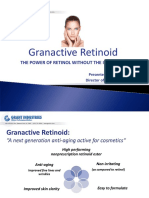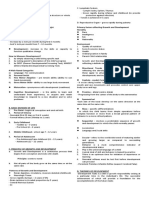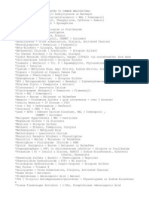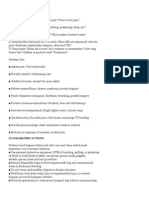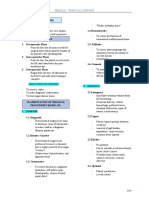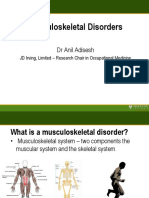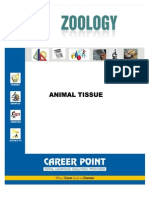Review of Systems ANDREA
Review of Systems ANDREA
Uploaded by
Andrea Dora OrtalizCopyright:
Available Formats
Review of Systems ANDREA
Review of Systems ANDREA
Uploaded by
Andrea Dora OrtalizCopyright
Available Formats
Share this document
Did you find this document useful?
Is this content inappropriate?
Copyright:
Available Formats
Review of Systems ANDREA
Review of Systems ANDREA
Uploaded by
Andrea Dora OrtalizCopyright:
Available Formats
Submitted by: Andrea Dora J. Ortaliz MD-3 Submitted to: Dr.
Apolto-Garcia
Review of Systems
General. Usual weight, recent weight change, any clothes that fit more
tightly or loosely than before. Weakness, fatigue, fever.
Skin. Rashes, lumps, sores, itching, dryness, color change, changes in
hair or nails.
Head, Eyes, Ears, Nose, Throat (HEENT). Head: Headache, head injury,
dizziness, lightheadedness. Eyes: Vision, glasses or contact lenses, last
examination, pain, redness, excessive tearing, double vision, blurred vision,
spots, specks, flashing lights, glaucoma, cataracts. Ears: Hearing, tinnitus, vertigo,
earaches, infection, discharge. If hearing is decreased, use or nonuse of
hearing aids. Nose and sinuses: Frequent colds, nasal stuffiness, discharge, or
itching, hay fever, nosebleeds, sinus trouble. Throat (or mouth and pharynx):
Condition of teeth, gums, bleeding gums, dentures, if any, and how they
fit, last dental examination, sore tongue, dry mouth, frequent sore throats,
hoarseness.
Neck. Lumps, “swollen glands,” goiter, pain, or stiffness in the neck.
Breasts. Lumps, pain or discomfort, nipple discharge, self-examination
practices.
Respiratory. Cough, sputum (color, quantity), hemoptysis, dyspnea,
wheezing, pleurisy, last chest x-ray. You may wish to include asthma, bronchitis,
emphysema, pneumonia, and tuberculosis.
Cardiovascular. Heart trouble, high blood pressure, rheumatic fever,
heart murmurs, chest pain or discomfort, palpitations, dyspnea, orthopnea,paroxysmal nocturnal dyspnea,
edema, past electrocardiographic or otherheart test results.
Gastrointestinal. Trouble swallowing, heartburn, appetite, nausea,
bowel movements, color and size of stools, change in bowel habits, rectal
bleeding or black or tarry stools, hemorrhoids, constipation, diarrhea. Abdominal
pain, food intolerance, excessive belching or passing of gas. Jaundice,
liver or gallbladder trouble, hepatitis.
Urinary. Frequency of urination, polyuria, nocturia, urgency, burning
or pain on urination, hematuria, urinary infections, kidney stones, incontinence;
in males, reduced caliber or force of the urinary stream, hesitancy,
dribbling.
Genital. Male: Hernias, discharge from or sores on the penis, testicular
pain or masses, history of sexually transmitted diseases and their treatments.
Sexual habits, interest, function, satisfaction, birth control methods,
condom use, and problems. Exposure to HIV infection. Female: Age at
menarche; regularity, frequency, and duration of periods; amount of bleeding,
bleeding between periods or after intercourse, last menstrual period;
dysmenorrhea, premenstrual tension; age at menopause, menopausal symptoms,
postmenopausal bleeding. If the patient was born before 1971, exposure
to diethylstilbestrol (DES) from maternal use during pregnancy. Vaginal
discharge, itching, sores, lumps, sexually transmitted diseases and
treatments. Number of pregnancies, number and type of deliveries, number
of abortions (spontaneous and induced); complications of pregnancy; birth
control methods. Sexual preference, interest, function, satisfaction, any problems,
including dyspareunia. Exposure to HIV infection.
Peripheral Vascular. Intermittent claudication, leg cramps, varicose
veins, past clots in the veins.
Musculoskeletal. Muscle or joint pains, stiffness, arthritis, gout, and
backache. If present, describe location of affected joints or muscles, presence
of any swelling, redness, pain, tenderness, stiffness, weakness, or limitation
of motion or activity; include timing of symptoms (for example, morning or
evening), duration, and any history of trauma.
Neurologic. Fainting, blackouts, seizures, weakness, paralysis, numbness
or loss of sensation, tingling or “pins and needles,” tremors or other involuntary
movements.
Hematologic. Anemia, easy bruising or bleeding, past transfusions
and/or transfusion reactions.
Endocrine. Thyroid trouble, heat or cold intolerance, excessive sweating,
excessive thirst or hunger, polyuria, change in glove or shoe size.
Psychiatric. Nervousness, tension, mood, including depression, memory
change, suicide attempts, if relevant.
No. Cranial Nerve Function
I Olfactory Sense of smell
II Optic Vision
III Oculomotor Pupillary constriction, opening the eye, and most
extraocular movements
IV Trochlear Downward, inward movement of the eye
VI Abducens Lateral deviation of the eye
V Trigeminal Motor—temporal and masseter muscles (jaw
clenching), also lateral movement of the jaw
Sensory—facial. The nerve has three divisions:
(1) ophthalmic, (2) maxillary, and (3) mandibular.
VII Facial Motor—facial movements, including those of facial
expression, closing the eye, and closing the mouth
Sensory—taste for salty, sweet, sour, and bitter
substances on the anterior two thirds of the tongue
VIII Acoustic Hearing (cochlear division) and balance (vestibular
division)
IX Glossopharyngeal Motor—pharynx
Sensory—posterior portions of the eardrum and ear
canal, the pharynx, and the posterior tongue,
including taste (salty, sweet, sour, bitter)
X Vagus Motor—palate, pharynx, and larynx
Sensory—pharynx and larynx
XI Spinal accessory Motor—the sternomastoid and upper portion of the trapezius
XII Hypoglossal Motor—tongue
STRATEGIES TO ASSESS CRANIAL NERVES IN NEWBORNS AND INFANTS
CRANIAL NERVES STRATEGY
I Olfactory Difficult to test
II Visual acuity Have baby regard your face and look for
facial response and tracking.
II, III Response to light Darken room, raise baby to sitting
position to
open eyes.
Use light and test for optic blink reflex
(blinking in response to light).
Use the otoscope (without a speculum)
to
assess papillary responses.
III, IV, VI Extraocular movements Observe tracking as the baby regards
your
smiling face move side-to-side.
Use light if needed.
V Motor Test rooting reflex.
Test sucking reflex (watch baby suck
breast,
bottle, or possibly pacifier).
VII Facial Observe baby crying and smiling, note
symmetry of face and forehead.
VIII Acoustic Test acoustic blink reflex (blinking of
both
eyes in response to loud noise).
Observe tracking in response to sound.
IX, X Swallow Observe coordination during
Gag swallowing.
Test for gag reflex.
XI Spinal accessory Observe symmetry of shoulders.
XII Hypoglossal Observe coordination of swallowing,
sucking,
and tongue thrusting.
Pinch nostrils, observe reflex opening of
mouth with tip of tongue to midline.
Primitive Reflexes That Should Be Part of the Routine Neurologi
Primitive Reflexes Age
Palmar grasp reflex birth to 3-4months
Plantargrasp reflex birth to 6-8 months
Moro reflex birth to 4 months
Asymmetric tonic neck reflex birth to 2 months
Positive support reflex birth or 2 months until 6 months
Rooting reflex birth to 3-4 months
Trunk incurvation reflex birth to 2 months
Placing and stepping reflex birth and variable age to disappear
Landau reflex birth to 6 months
Parachute reflex 4-6 months and does not disappear
PRIMITIVE REFLEXES THAT SHOULD BE PART OF THE ROUTINE NEUROLOGIC EXAMINATION OF INFANTS
Primitive Reflex Maneuver Ages
Palmar Place your fingers into the Birth to Persistence beyond 4 mos
Grasp baby’s hands and press 3–4 mos suggests
Reflex against the palmar cerebral dysfunction.
surfaces. Persistence of clenched hand
The baby will flex all beyond 2
fingers to grasp your mos suggests central nervous
fingers system
damage, especially if fingers
overlap
thumb
Plantar Touch the sole at the base Birth to Persistence beyond 8 mos
Grasp of the toes. 6–8 mos suggests
Reflex The toes curl. cerebral dysfunction.
Moro Hold the baby supine, Birth to Persistence beyond 4 mos
Reflex supporting the head, 4–6 mos suggests
(Startle back, and legs. Abruptly neurologic disease; beyond 6
Reflex)
lower the entire body mos
about 2 feet. strongly suggests it.
The arms abduct and
extend, hands open, and
legs flex. Baby may cry.
Asymmetric With baby supine, turn Birth to Persistence beyond 2 mos
Tonic head to one side, holding 2 mos suggests
Neck jaw over shoulder.
Reflex The arms/legs on side to neurologic disease.
which head is turned
extend while the
opposite arm/leg flex.
Repeat on other side.
Positive Hold the baby around the Birth or Lack of reflex suggests
Support trunk and lower until the 2 mos hypotonia or
Reflex feet touch a flat surface. until flaccidity.
The hips, knees, and 6 mos Fixed extension and
ankles extend, the baby adduction of legs
stands up, partially (scissoring) suggests
bearing weight, sags after spasticity due to
20–30 seconds. neurologic disease.
ADDITIONAL PRMITIVE REFLEXES THAT SHOULD BE TESTED IF NEUROLOGIC
ABNORMALITY IS SUSPECTED
Primitive Reflex Maneuver Ages
Rooting Stroke the perioral skin Birth to Absence of rooting indicates
Reflex at the corners of the 3–4 mos severe generalized
mouth. or central nervous system
The mouth will open disease.
and baby will turn
the head toward the
stimulated side and
suck.
Trunk Support the baby Birth to Absence suggests a transverse
Incurvation prone with one hand, 2 mos spinal cord
(Galant’s) and stroke one side lesion or injury.
Reflex
of the back 1 cm Persistence may indicate
from midline, from delayed development
shoulder to buttocks.
The spine will curve
toward the
stimulated side.
Placing Hold baby upright Birth Absence of placing may
and from behind as in (best indicate paralysis.
Stepping positive support after 4 Babies born by breech
Reflexes
reflex. Have one sole days). delivery may not
touch the tabletop. Variable have placing reflex.
The hip and knee of age to
that foot will flex and disappear
the other foot will
step forward.
Alternate stepping will
occur.
Landau Suspend the baby Birth to Persistence may indicate
Reflex prone with one hand. 6 mos delayed development.
The head will lift up
and the spine will
straighten
Parachute Suspend the baby 4–6 mos Delay in appearance may
Reflex prone and slowly and does predict future
lower the head not delays in voluntary motor
toward a surface. disappear development
The arms and legs will
extend in a protective
fashion.
You might also like
- Case Simu 101Document5 pagesCase Simu 101Princess Levie CenizaNo ratings yet
- Ati Comprehensive Predictor 2019 ADocument51 pagesAti Comprehensive Predictor 2019 Aanahmburu966No ratings yet
- Ginger As Purifier 1Document23 pagesGinger As Purifier 1Micah Louise Aliviado100% (2)
- Granactive Retinoid (Grant Industries)Document19 pagesGranactive Retinoid (Grant Industries)Rizqi AmaliyahNo ratings yet
- Case Simulation 3 in Pediatric NursingDocument3 pagesCase Simulation 3 in Pediatric NursingCaren Marquez100% (1)
- Root Cause AnalysisDocument7 pagesRoot Cause Analysisapi-3163522290% (1)
- Sabre 25HE CombiDocument44 pagesSabre 25HE CombiRon Lester0% (1)
- MEDSURG 1 NotesDocument43 pagesMEDSURG 1 NotesNEIL NETTE S. REYNALDONo ratings yet
- Physiological IntegrityDocument317 pagesPhysiological IntegrityMoreiyamNo ratings yet
- List of Drug OtotoxicDocument3 pagesList of Drug OtotoxicLukas I Nyoman Yesaya CavinNo ratings yet
- Hematologic System2Document70 pagesHematologic System2Jesus Mario LopezNo ratings yet
- Ob Peds Meds ListDocument15 pagesOb Peds Meds ListVin Lorenzo Campbell100% (1)
- Suffixes and PrefixesDocument2 pagesSuffixes and PrefixesNiksNo ratings yet
- Pediatric NursingDocument20 pagesPediatric Nursingjannah ymbongNo ratings yet
- NCLEX 15 WK 1critical ThinkingDocument2 pagesNCLEX 15 WK 1critical ThinkingNikita TamrakarNo ratings yet
- Different Positions Assumed by A Patient During A Physical Examination ProcedureDocument14 pagesDifferent Positions Assumed by A Patient During A Physical Examination ProcedureAziil LiizaNo ratings yet
- Antidotes To Common MedicationsDocument2 pagesAntidotes To Common MedicationsbionikaNo ratings yet
- Nursing NotesDocument3 pagesNursing NotesMaria Clara IdaNo ratings yet
- Which Signs and Symptoms Would The Nurse Expect To Assess in A Newborn WithDocument1 pageWhich Signs and Symptoms Would The Nurse Expect To Assess in A Newborn WithjamesNo ratings yet
- NCLEX: From UworldDocument26 pagesNCLEX: From UworldOlgaKNo ratings yet
- Prioritization Beyond ABCSDocument1 pagePrioritization Beyond ABCSMary-Lyne LausNo ratings yet
- Focused ReviewDocument6 pagesFocused ReviewGina GiammalvoNo ratings yet
- Head To Toe Review of SystemsDocument1 pageHead To Toe Review of SystemsSNo ratings yet
- Potential Complications Signs and SymptomsDocument2 pagesPotential Complications Signs and SymptomsJessica GomezNo ratings yet
- Perioperative Nursing ManagementDocument19 pagesPerioperative Nursing ManagementSarah SeverreNo ratings yet
- Physical Assessment Learning Guide Med SurgDocument4 pagesPhysical Assessment Learning Guide Med SurgTremain LinsonNo ratings yet
- Task Delegations For NclexDocument3 pagesTask Delegations For Nclexjenn_028No ratings yet
- Chapter 19 Introduction To Nerves and The Nervous SystemDocument27 pagesChapter 19 Introduction To Nerves and The Nervous SystemFugado Mica illaNo ratings yet
- MS Final 46 Blood or Lymphatic DisorderDocument4 pagesMS Final 46 Blood or Lymphatic DisorderZachary T Hall0% (1)
- ATI Pain and InflammationDocument3 pagesATI Pain and InflammationAnna100% (1)
- Top 30 Nclex Meds: Study Online atDocument2 pagesTop 30 Nclex Meds: Study Online atVanessaMUellerNo ratings yet
- This Study Resource Was: Hesi Pharmacology Test Bank 2018 RN V2 14 Total QuestionsDocument3 pagesThis Study Resource Was: Hesi Pharmacology Test Bank 2018 RN V2 14 Total QuestionsCrystal B Costa78No ratings yet
- Buletin Lp.3Document2 pagesBuletin Lp.3Joana B. NikolovaNo ratings yet
- DOCU - MedA Charting GuidelinesDocument3 pagesDOCU - MedA Charting GuidelinesJesus Mario LopezNo ratings yet
- NPDADocument52 pagesNPDAAlondra MangandogNo ratings yet
- Constipation AlgorithmDocument1 pageConstipation AlgorithmIYERBKNo ratings yet
- Nursing TipsDocument15 pagesNursing Tipsnene lewisNo ratings yet
- RN Thread NclexDocument21 pagesRN Thread NclexMaria Nadia MihalikNo ratings yet
- Meds - KaplanDocument3 pagesMeds - KaplanJodi BairNo ratings yet
- Med Surg BkatDocument8 pagesMed Surg BkatLucilia Nunes0% (1)
- HESIDocument2 pagesHESIElizabeth100% (1)
- Top DrugsDocument12 pagesTop DrugsStephanie Villanueva AdvinculaNo ratings yet
- UntitledDocument41 pagesUntitledvioletdeocaresNo ratings yet
- An Easy Guide To Head To Toe Assessment Vrtis 2011-1 PDFDocument6 pagesAn Easy Guide To Head To Toe Assessment Vrtis 2011-1 PDFkatherine dayag100% (1)
- DO NOT Delegate What You Can EATDocument1 pageDO NOT Delegate What You Can EATMerlin JosephNo ratings yet
- Kaplan Nclex ReviewDocument13 pagesKaplan Nclex ReviewOlgaKNo ratings yet
- Fluids Electrolytes Visual NotesDocument8 pagesFluids Electrolytes Visual NotesVin Lorenzo CampbellNo ratings yet
- Paed Parenteral Fluid ThyDocument1 pagePaed Parenteral Fluid ThyZulia Ahmad BurhaniNo ratings yet
- AdultDocument295 pagesAdultKen WonNo ratings yet
- Cardiovascular System Drugs - Active Stack® Pharmacology Flash Cards - Study Materials - My ATIDocument1 pageCardiovascular System Drugs - Active Stack® Pharmacology Flash Cards - Study Materials - My ATIAntonette Joy SolinapNo ratings yet
- ATI RN Fundamentals Practice Tests A & B Questions With Verified Correct AnswersDocument24 pagesATI RN Fundamentals Practice Tests A & B Questions With Verified Correct AnswersdecotienoNo ratings yet
- Muscoskeletal DisordersDocument17 pagesMuscoskeletal DisordersAntonio Andag SalasNo ratings yet
- PT Seated, Facing Examiner Doctor-Pt Interactions: Response To Light (CN II, III) & Visual Fields (CN II)Document2 pagesPT Seated, Facing Examiner Doctor-Pt Interactions: Response To Light (CN II, III) & Visual Fields (CN II)Anonymous fj68MsNo ratings yet
- Preventing AbuseDocument13 pagesPreventing AbuseKim Olsen100% (1)
- Disease Causative Agent Diagnosis Classification/ S&S TreatmentDocument4 pagesDisease Causative Agent Diagnosis Classification/ S&S Treatmentfreya_28No ratings yet
- Head To Toe AssessmentDocument3 pagesHead To Toe Assessmentsandaman2225No ratings yet
- Anatomy and Physiology of The EyeDocument2 pagesAnatomy and Physiology of The EyeKeanu Jay MaltosNo ratings yet
- New Born Care 1Document12 pagesNew Born Care 1gilbertgarciaNo ratings yet
- SBARQ FormDocument1 pageSBARQ FormTracy100% (5)
- Adrenergic AgonistsDocument18 pagesAdrenergic AgonistsJod Bell100% (1)
- ATI Medication Template RanitidineDocument1 pageATI Medication Template RanitidineSharee HaywoodNo ratings yet
- Physical Diagnosis Information OverviewDocument119 pagesPhysical Diagnosis Information OverviewNarcis PopaNo ratings yet
- NURSING CARE OF ADULTS II: Passbooks Study GuideFrom EverandNURSING CARE OF ADULTS II: Passbooks Study GuideNo ratings yet
- COMPREHENSIVE NURSING ACHIEVEMENT TEST (RN): Passbooks Study GuideFrom EverandCOMPREHENSIVE NURSING ACHIEVEMENT TEST (RN): Passbooks Study GuideNo ratings yet
- Catalogo Completo Hu FriedyDocument632 pagesCatalogo Completo Hu FriedyAndres Alberto Sanchez LaraNo ratings yet
- Thesis Statement For Nickel and DimedDocument8 pagesThesis Statement For Nickel and Dimedafkntwbla100% (2)
- XI Chemistry Study Materials Class XI 281022 221029 203855-1Document187 pagesXI Chemistry Study Materials Class XI 281022 221029 203855-1Charvi100% (1)
- CH 5 Coordination CompoundsDocument22 pagesCH 5 Coordination CompoundsNafeesNo ratings yet
- Zoology Animal TissueDocument54 pagesZoology Animal TissueasuhassNo ratings yet
- La5 Perpetuation of LifeDocument13 pagesLa5 Perpetuation of LifeRenz Bilbao SabonsolinNo ratings yet
- Program Sheet 2024Document15 pagesProgram Sheet 2024Mahabub Hossain KhanNo ratings yet
- 5 JapaneseEncephalitis SipDocument52 pages5 JapaneseEncephalitis SipTiara AmbarNo ratings yet
- A1 Reading and VocabDocument60 pagesA1 Reading and VocabVũ Quốc ĐạiNo ratings yet
- Impact of Climate Change On BirdsDocument7 pagesImpact of Climate Change On BirdsMădălina DimaNo ratings yet
- Introd of Fall Protection - Oil and Gas - Capital SafetyDocument71 pagesIntrod of Fall Protection - Oil and Gas - Capital SafetyGustavo Carnevali MendesNo ratings yet
- Requirements in Renewing Business PermitDocument1 pageRequirements in Renewing Business PermitCharina Marie CaduaNo ratings yet
- Manual de Operacion Ep Es14-30wa (Pds30) Es18-40wa (Pds40) 20120806Document34 pagesManual de Operacion Ep Es14-30wa (Pds30) Es18-40wa (Pds40) 20120806Ricardo Gamez OrtegaNo ratings yet
- Should Abortion Be Illegal EssayDocument5 pagesShould Abortion Be Illegal Essaylwfdwwwhd100% (2)
- RN ResumeDocument2 pagesRN Resumeapi-519736590No ratings yet
- Ethics of Nursing Shift ReportDocument5 pagesEthics of Nursing Shift ReportkelllyNo ratings yet
- Brunch TartasDocument1 pageBrunch TartasAna Milena RuedaNo ratings yet
- Ultrasonic Testing and Acceptance Standard For Fabricated Armature ShaftDocument4 pagesUltrasonic Testing and Acceptance Standard For Fabricated Armature ShaftveeramalaiNo ratings yet
- Enviromental Wellness (Draft)Document14 pagesEnviromental Wellness (Draft)KieyNo ratings yet
- Olympic Movement Notes 2021Document16 pagesOlympic Movement Notes 2021andzile3No ratings yet
- ASSAB Tool Steel Performance Chart A4 enDocument2 pagesASSAB Tool Steel Performance Chart A4 en6310520% (1)
- PMF 017 HSE 007 - 02 HSE Observations RegisterDocument3 pagesPMF 017 HSE 007 - 02 HSE Observations RegisterMohammedSajidNo ratings yet
- Q1 LAS1 MELC1 Week 12Document6 pagesQ1 LAS1 MELC1 Week 12Carl Seigfred GarciaNo ratings yet
- Communicable Disease Nursing ENHANCER Day 2Document1 pageCommunicable Disease Nursing ENHANCER Day 2Mcbry TiongNo ratings yet
- Cvs ExaminationDocument1 pageCvs ExaminationAnn SyaNo ratings yet
- Effect of Modular Distance Learning To The Academic Performance of Grade 12 Students of Palandok National High SchoolDocument5 pagesEffect of Modular Distance Learning To The Academic Performance of Grade 12 Students of Palandok National High SchoolMyza TaminNo ratings yet



